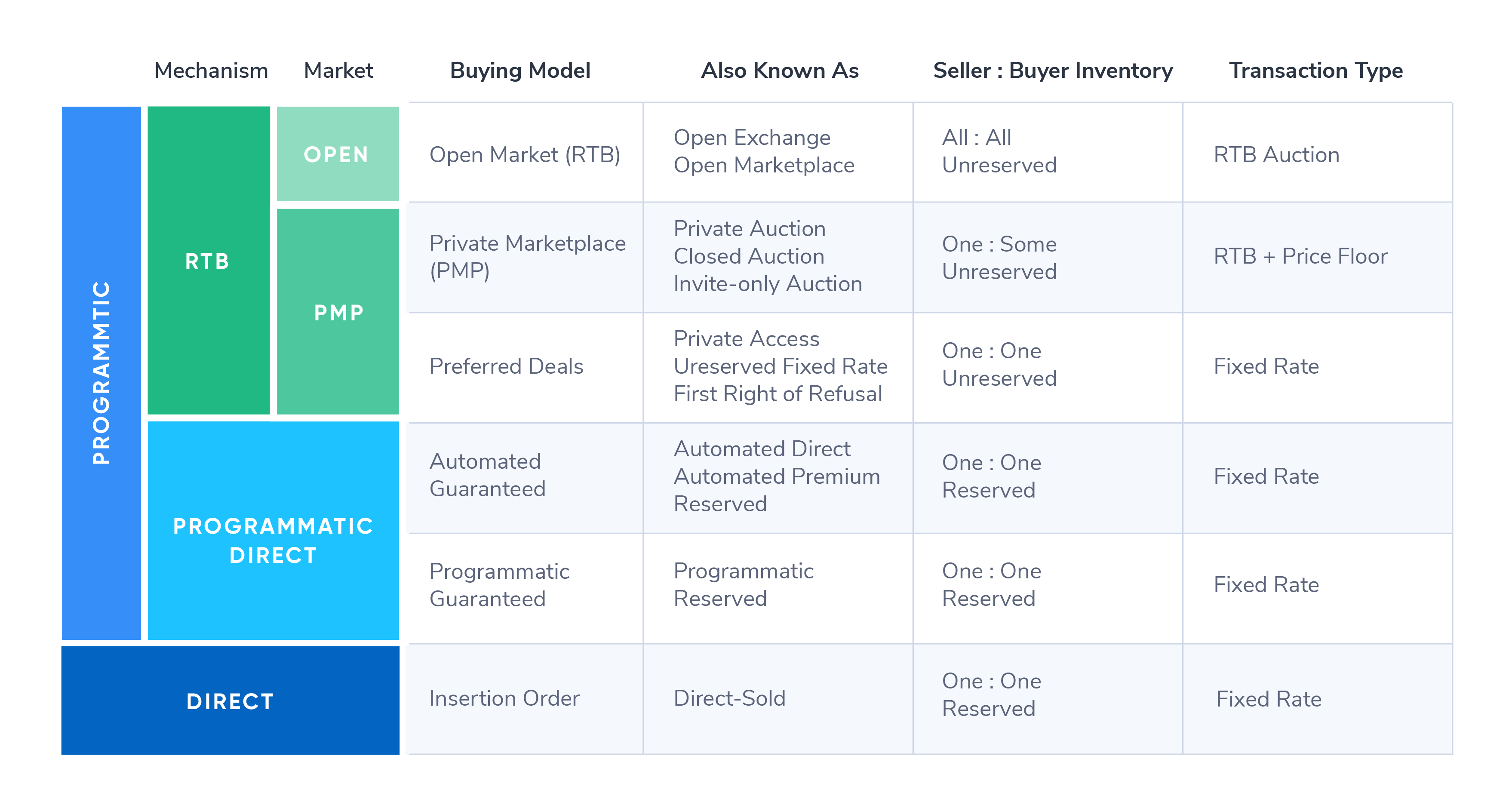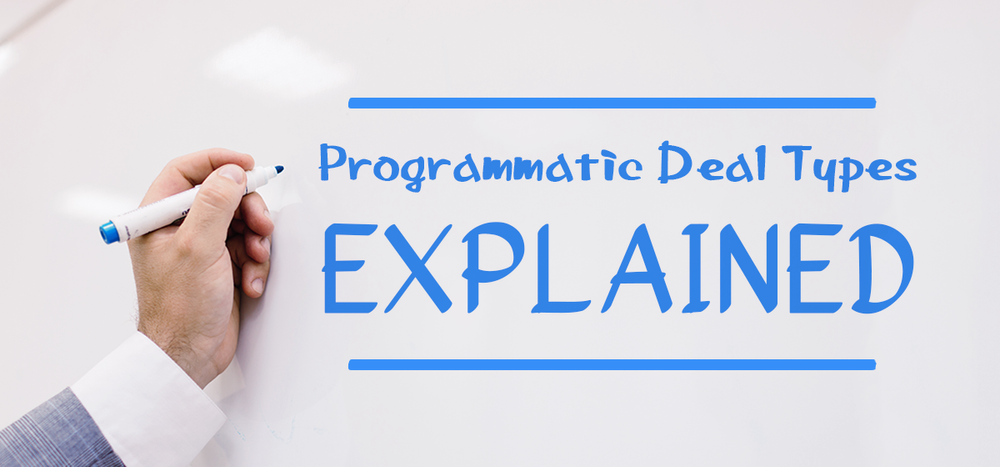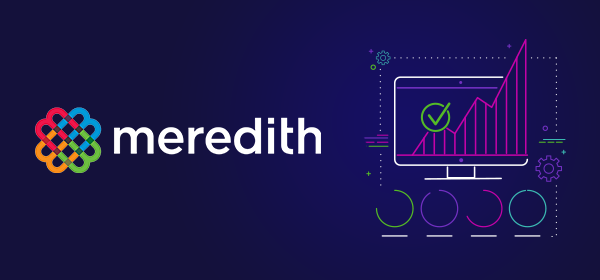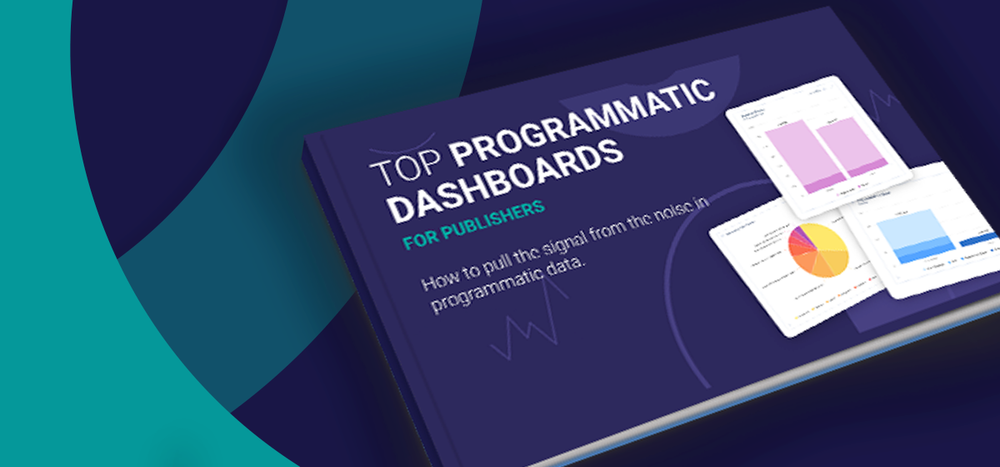The programmatic pie is expected to grow 19% in 2019 to $84B, accounting for 65% of all money spent on digital media, according to Zenith. This is a huge opportunity for publishers to monetize inventory, but you might be leaving money on the table if you’re not taking advantage of each type of programmatic deal. The key to maximizing revenue is to know just as much about the ways deals can be structured as you do about your inventory. In this post, we break down the various deal types in the programmatic space, review their respective strengths and weaknesses, and share how to leverage each to grow revenue overall.

Open Marketplace RTB
Also known as: Open exchange, open marketplace, RTB
Participation: All buyers on a platform
Ad Server Priority: Lowest (just above in-house ads)
Overview
Real-time bidding (RTB) is a technology that enables the buying and selling of digital ad impressions through live auctions. RTB impressions are available to all bidders; every advertiser on an exchange/SSP/ad network gets the impression call, they all bid, and the highest bidder wins (usually via second-price/Vickery auction). Publishers earn a share of that price, depending on the winning platform’s compensation terms.
Channel Strategy
- Optimizing yield is less time-consuming because there are fewer controls.
- Unlimited demand.
- Open auctions can help find relevant advertisers amongst a global market.
- Targeting strategies enhance the value of impressions for buyers.
Publisher Concerns
- Newly introduced formats, such as audio or certain rich media ads, can be difficult to transact through the open exchange, either for technical reasons or because demand has yet to build (driving competition and prices).
- The blind buy-and-sell environment creates an opportunity for brand-risk and fraud.
- Pinpointing the source of malicious ads can be difficult due to media arbitrage and transparency issues.
Publisher Controls
- Maintain block-lists to exclude unwanted buyers.
- Manage price floors to raise the bid amount (keep in mind this will reduce bid density—fewer advertisers competing in the auction).
Private Marketplace (PMP)
Also known as: Private auction, invitation-only auction, closed auction Participation: Restricted to included (invited) buyers only Ad Server Priority: Higher than open auction
Overview
Private Marketplaces are a method to limit the sale of ads to only pre-selected bidders. These are invitation-only marketplaces that give more control over margin to the publisher. Unlike a direct buy, which can be quite labor-intensive, buyers in a Private Marketplace use programmatic methods to purchase from publishers.
PMP inventory is considered ‘premium.’ Publishers offer ad inventory packages (built around audience data, impression attributes, content type, and more) to a group of buyers pre-approved by publisher.
Inventory packages are identified by Deal ID, which is a unique string of characters that defines things like priority, transparency, floor pricing, and/or data. The Deal ID is shared with select buyers, which allows those buyers to purchase identified inventory programmatically through a DSP.
Channel Strategy
- Inventory offered through deals should create incremental value for buyers compared to what is available on the open exchange.
- Deal IDs can increase margin for publishers by setting pricing parameters.
- PMP deals alleviate brand-safety concerns for buyers.
Publisher Concerns
- Buyers can compare open auction prices to PMPs and aren’t committed to inventory.
- Prime fraud target: According to WhiteOps report, publishers selling high-priced video inventory on PMPs were the prime target of the extremely sophisticated Methbot operation, which spoofed domains and faked clicks on ad impressions.
- It may be difficult to maintain high enough fill-rate to surpass open auction revenue.
Publisher Controls
- Extra exclusivity and control in terms of ad revenue optimization.
- Advertisers have greater transparency into inventory.
- Less data leakage: Impression data isn’t passed to every buyer on an exchange.
- Better buyer relationships: Publishers know who is buying their inventory packages and can use this information to give first-look privileges. [see Preferred Deals below]
Preferred Deals
Also known as: Unreserved fixed rate, private access, first right of refusal, spot buying Participation: One buyer Ad Server Priority: High (above open and private auctions)
Overview
Preferred deals are between a publisher and a specific buyer for a fixed-price CPM, usually focused on audience. In return, publishers give the buyer priority and exclusive access to inventory before it is made available to everyone else in private, and then open auction.
Channel Strategy
- Impressions are not guaranteed, but audience is—buyers’ DSP can use audience data to review every ad impression before they decide to buy it.
- Highly targeted ads create a better UX for a publisher’s audience: Impressions won in preferred deals are shown to very specific audiences enriched by DSP data, making it more relevant to your visitors.
- Better buyer relationships: Buyers reach out directly to publishers for first-look privilege and price negotiation.
Publisher Concerns
- Downlift risk: With less competition, the impressions bought in preferred deals may get sold at a lower price.
- Potentially low fill: The buyer has the privilege to accept or reject an impression depending on their requirement. For this reason, it’s important to price and segment the inventory appropriately.
- If multiple buyers bid at the fixed price set for them, the highest fixed price wins. If the fixed prices are the same for all those buyers, one buyer is chosen at random from that set.
Publisher Controls
- You negotiate privately with the buying party.
- Audiences can be very narrowly defined.
- Creative control: You can review and approve the campaign creatives beforehand.
- Better buyer relationships: Publishers know who is buying their inventory packages and can use this information to give first-look privileges. [see Preferred Deals below]
Automated Guaranteed (AG)
Also known as: Automated direct, automated premium, reserved Participation: One buyer Ad Server Priority: Highest (same as manual direct deals)
Overview
Automated Guaranteed is the automation of traditional direct-sold deals—negotiated directly between sellers and buyers and facilitated by a technology platform. In these deals, the RFP and campaign trafficking processes are automated, inventory (usually premium) and pricing are guaranteed, and flight/run-time is fixed. Once the deal is signed off, it is fed straight into the publisher’s ad server via the ad server API.
Channel Strategy
- Guaranteed revenue for inventory—predictable financial forecasting.
- Opportunity to develop better relationships with buyers during in-person negotiation, campaign setup, and delivery.
- Buyers have reduced concerns about brand safety.
- 50% more efficient than traditional direct-sold deals (BCG Report, 2018).
- Automated processes provide more transparency, a value-add for advertisers; deals should be priced accordingly.
Publisher Concerns
- Can’t accurately predict how viewability or other 3rd-party metrics will affect campaign delivery.
- More resource-intensive than RTB and PMP deals: Campaigns still require oversight to ensure complete delivery.
Publisher Controls
- Direct integration with publishers’ ad servers allow for real-time availability of impressions and direct line item insertion for trafficking.
- Creatives can be approved ahead of time to ensure quality UX.
Programmatic Guaranteed
Also known as: Programmatic premium; automated guaranteed (differences explained below) and programmatic direct (usually an umbrella term for preferred and automated guaranteed, and sometimes PMPs) Participation: One buyer Ad Server Priority: Highest (same as manual direct deals)
Overview
Programmatic Guaranteed is the buying of impressions with a guaranteed delivery (reserved traffic) or spend (fixed price) using an programmatic platform and Deal ID. In these deals, the buyer knows exactly what audience and content they want, and when—buyers may apply additional audience targeting (via DMP or CDP), filters, and frequency caps during campaign run time. Programmatic Guaranteed is sometimes called the “best of both worlds” because it leverages the efficiencies of automation, guarantees pricing for publishers, and allows buyers to choose the audience and impressions to bid on.
Channel Strategy
- Guarantees pricing.
- Premium CPMs can be charged in exchange for more access to targeting.
- UX is improved because ads are more appropriate and targeted.
- 50% more efficient than traditional direct-sold deals (BCG Report, 2018).
- Automated processes provide more transparency, a value-add for advertisers; deals should be priced accordingly.
Publisher Concerns
- Forecasting delivery is much more difficult because the buyer sets the audience targeting and decides which impressions to buy. This can lead to an over- or under-delivery on impressions.
Publisher Controls
- Set pricing guarantees.
- Choice of buyers to work with.
Other
Automated Performance (AP)
Automated Performance is workflow automation, similar to Automated Guaranteed, but for these deals campaign performance is guaranteed, rather than impressions. The two main performance metrics for these deals are cost-per-click (CPC) or cost-per-install (CPI).
To sum it up, each deal type works best for certain kinds of inventory—the more exclusive the invitation, the more premium the inventory—and helps publishers balance revenue and UX. Each also provides an opportunity for relationship-building through discovery, targeting, data overlay, etc. which helps publishers stand out in the marketplace. The best way to achieve and maintain high CPMs and fill rates is to take advantage of each deal type’s strength to identify the inventory and data that each buyer needs to accomplish their goals.
Interested in setting up reporting and analytics to manage your programmatic activities? We’ve been supporting publishers for over 10 years and would be happy to talk about strategies to increase revenue and set you apart from the competition. Contact Us >






